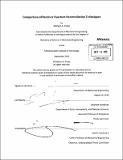| dc.contributor.advisor | Stéphane Rondenay. | en_US |
| dc.contributor.author | Pesce, Kathryn A | en_US |
| dc.contributor.other | Massachusetts Institute of Technology. Dept. of Mechanical Engineering. | en_US |
| dc.date.accessioned | 2011-05-09T15:29:36Z | |
| dc.date.available | 2011-05-09T15:29:36Z | |
| dc.date.issued | 2010 | en_US |
| dc.identifier.uri | http://hdl.handle.net/1721.1/62748 | |
| dc.description | Thesis (S.B.)--Massachusetts Institute of Technology, Dept. of Mechanical Engineering, September 2010. | en_US |
| dc.description | "September 2010." Cataloged from PDF version of thesis. | en_US |
| dc.description | Includes bibliographical references (p. 33-34). | en_US |
| dc.description.abstract | Receiver function (RF) techniques are commonly used by geophysicists to image discontinuities and estimate layer thicknesses within the crust and upper mantle. A receiver function is a time-series record of the P-to-S (Ps) teleseismic wave conversions within the earth and can be viewed as the Earth's impulse response. An RF is extracted from seismic data by deconvolving the observed trace from an estimate of the source wavelet. Due to the presence of noise in the data, the deconvolution is unstable and must be regularized. Six deconvolution techniques are evaluated and compared based on their performance with synthetic data sets. These methods approach the deconvolution problem from either the frequency or time domain; some approaches are based on iterative least-squares inversions, while others perform a direct inverse of the problem. The methods also vary in their underlying assumptions concerning the noise distribution of the data set, level of automation, and the degree of objectivity used in deriving or choosing the regularization parameter. The results from this study provide insight into the situations for which each deconvolution method is most reliable and appropriate. | en_US |
| dc.description.statementofresponsibility | by Kathryn A. Pesce. | en_US |
| dc.format.extent | 61 p. | en_US |
| dc.language.iso | eng | en_US |
| dc.publisher | Massachusetts Institute of Technology | en_US |
| dc.rights | M.I.T. theses are protected by
copyright. They may be viewed from this source for any purpose, but
reproduction or distribution in any format is prohibited without written
permission. See provided URL for inquiries about permission. | en_US |
| dc.rights.uri | http://dspace.mit.edu/handle/1721.1/7582 | en_US |
| dc.subject | Mechanical Engineering. | en_US |
| dc.title | Comparison of receiver function deconvolution techniques | en_US |
| dc.type | Thesis | en_US |
| dc.description.degree | S.B. | en_US |
| dc.contributor.department | Massachusetts Institute of Technology. Department of Mechanical Engineering | |
| dc.identifier.oclc | 717581780 | en_US |
